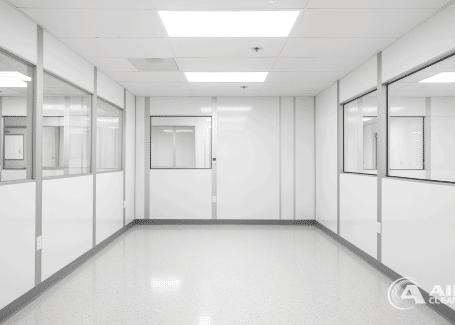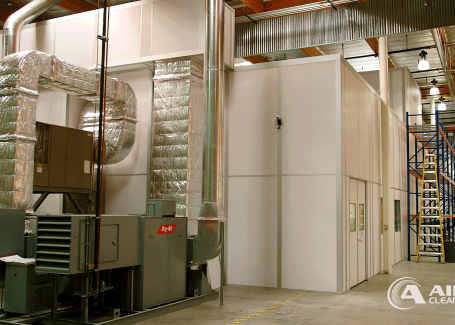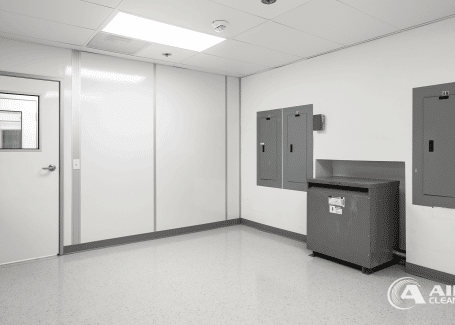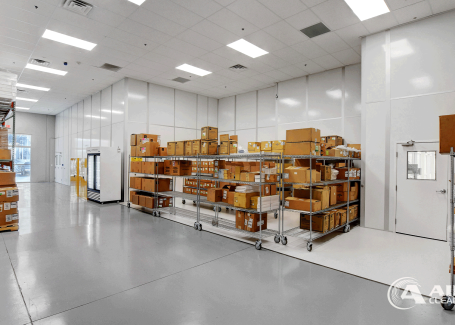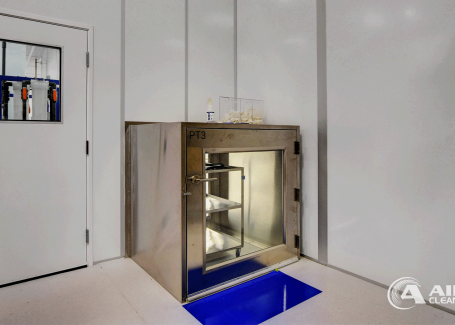Healthcare & Hospital Cleanrooms
In the world of healthcare, contamination isn’t a mere technical issue, it’s a direct danger to patient safety and clinical integrity. Hospital cleanrooms are critical areas intended to protect sterile compounding, surgeries, diagnostics, and research from dangerous germs and particulates. The spaces are not only sterile but also engineered ecosystems governed by compliance, control, and continuity of care. Engineered for top-level performance, our healthcare solutions offer a modular approach and infection control that is airtight, all without disturbance to your sensitive hospital environment.

Why Healthcare Cleanrooms Matter
Every hospital and healthcare center struggles to keep an environment sterile in rooms full of human beings. Cleanrooms fill this void by offering the best environment possible for patients. Whether it’s reducing the risk of infection, supporting reliable diagnostic results, or ensuring that pharmaceutical and medical device production meets the highest sterility standards, these systems are essential. Without them, surgical results, patient recovery rates, and hospital reputations can suffer. Contamination control becomes a predictable science instead of a daily game to beat the odds.
For hospitals and clinics, cleanrooms are no longer optional but necessary for operations. From operating rooms to compounding pharmacies, sterile processing spaces, and diagnostic labs, clinical cleanrooms make meeting standards possible and sustainability measurable. They are designed to safeguard not just the lives of patients but also the trust that regulators and the public place in every healthcare institution.
Smart Design, Safe Performance
The architecture of cleanroom healthcare facilities seeks to strike a balance between highly technical medical needs and the architectural flexibility of construction. FRP or antimicrobial wall finishes on modular wall systems endure repeated cleaning, disinfecting, and heavy traffic. Non-shedding surfaces and coved corners remove areas where microorganisms can hide. Floors are sealed with heat-welded vinyl or epoxy, creating a seamless transition to the walls that is easy to clean.
Cleanroom-grade HEPA or ULPA filters ensure air quality and environmental stability to the point of 99.999% particle removal efficiency. Buildings can be designed to have positive pressure to protect sterile environments or negative pressure to safely contain biohazards. Systems automatically control temperature, humidity, and pressure differentials. The result is a backdrop that meets hospital standards and offers uncompromised sterility and safety.
Compliant and Built for Infection Prevention
The financial bottom line of a hospital cleanroom is preventing infection. It has been made under utmost care to not allow any form of microbial transfer or airborne contamination, every inch being planned and executed. Walls and ceilings have antimicrobial coatings to reduce bacteria. Gowning rooms, airlocks, and pass-throughs reduce potential for cross-contamination between clean and non-clean areas.
Modular cleanroom products also make maintenance and retrofits possible with minimal disruption to hospital operations. Rather than months of tearing up facilities and disposing of waste, prefab units can be installed quickly—and cleanly—a huge benefit in the active healthcare sector. These cleanrooms are built to conform to ISO 14644, FDA cGMP, EU GMP, and other healthcare-related standards for off-the-shelf regulatory compliance.
Compliance and Standards
Each hospital cleanroom must be constructed to meet, and ideally exceed, international and regional standards for performance. Compliance frameworks typically include ISO 14644 classifications and testing. FDA and EU GMP requirements apply to pharmaceutical-grade environments. HTA, HTM, and CDC or OSHA standards address healthcare facility safety and infection control.
These standards cover everything from particulate containment to gowning procedures and airflow management. When design and construction are aligned with them from the start, hospitals avoid costly retrofits and certification delays.
Applications Across Healthcare
Cleanrooms are an integral part of the healthcare system at all levels. Some common applications include:
- Clinical Environments: Hospitals and surgical suites require ISO-classified airflow systems to ensure sterility during high-stakes procedures. Radiopharmacy and nuclear medicine hot cells enable the aseptic synthesis of radioactive products. Blood transfusion labs, tissue culture suites, and forensic or DNA facilities require reliable air quality and containment systems to maintain valid results.
- Hospital Support Services: Sterile and disinfection units (HSDUs), medicine stores, and compounding areas rely on controlled environments to prevent cross-contamination. Mortuary containment zones use negative pressure to maintain safety and compliance. These systems support infection prevention programs and help hospitals meet zero-tolerance goals for contamination-related events.
- Advanced Therapies and Research: The future of medical science, from cell and gene therapies to CAR-T facilities and advanced biobanks, relies on precision-engineered cleanrooms. Laboratory facilities with high containment levels require highly tailored airflow and filtration to ensure biosafety. Diagnostics, tissue culture, and quality control labs operate under strict cleanroom classifications for results that are reliable, repeatable, and ready for regulatory scrutiny.
The Benefits of Advanced Hospital Cleanrooms
Modern medical cleanroom environments are more than sterile spaces; they are systems of performance and protection. Designed for reliability and responsiveness, they deliver measurable value in five key areas.
- Built to Comply: Meet manufacturing and cleanroom requirements for FDA cGMP, EU GMP, ISO 14644, and healthcare-specific HTA or HTM standards.
- Infection Prevention: Antimicrobial finishes, non-shedding surfaces, and controlled airflow maintain sterility around the clock.
- Very Little Downtime: Perfect for hospitals focused on future-proofing operations and minimizing M&E disruptions.
- Custom Fit: Tailored to each facility’s workflow, from patient-facing surgical rooms to secure research labs.
- Modular Design: Expand or modify as clinical needs change, without redesigning from scratch.
These compliant cleanrooms provide clarity, consistency, and confidence in every operation. Each system becomes part of a hospital’s long-term asset base, enhancing safety, efficiency, and reputation.
Customization Options for Healthcare Facilities
Every hospital is unique, and so is every cleanroom. Customization options make it easy to fit cleanroom systems into existing infrastructure and workflows. Here are a few common ways they can be configured:
- Materials: FRP, stainless steel, and antimicrobial wall or floor coatings for high-disinfectant applications.
- Pressure Systems: Positive-pressure cleanrooms for sterile areas and negative-pressure rooms for containment.
- System Integration: Interconnect with hospital BMS, alarms, monitoring, and autoclave systems.
- Design Options: Multi-room suites with gowning, compounding, and sterile preparation areas.
- Construction: Modular or off-site fabrication for faster deployment and reduced service downtime.
This flexibility ensures your cleanroom evolves alongside your healthcare services, supporting growth, safety, and profitability.
The Future of Healthcare Cleanrooms
The future of healthcare depends on precision, safety, and speed. Cleanrooms allow hospitals to meet modern standards while maintaining continuous patient care. They serve as the backbone of medical innovation, supporting high-acuity hospitals, diagnostic labs, and research centers.
Cleanrooms protect patients, empower medical professionals, and uphold the integrity of every diagnosis and treatment. In a world where infection control defines success, clinical cleanrooms are not a luxury, they are essential to any healthcare operation committed to excellence.
Built for the Real Hospital World
Hospitals are living workspaces. Our cleanrooms manage air, pressure, and infection risk while people work around them. ISO-rated filtration keeps the room clean and the focus on care, not constant maintenance.
Modular Design, No Long Shutdowns
Upgrades don’t have to stop surgery schedules. Prefab cleanroom sections roll in ready to fit existing systems, cutting noise and debris. It’s a cleaner, faster way to expand capacity without tearing apart the hospital.
Surfaces Made to Last
Every surface is chosen for endurance. The walls resist harsh cleaners, the floors stay sealed against moisture, and curved corners don’t trap dirt. After years of daily cleaning, the materials still hold their shape and finish, keeping your space easy to sanitize.
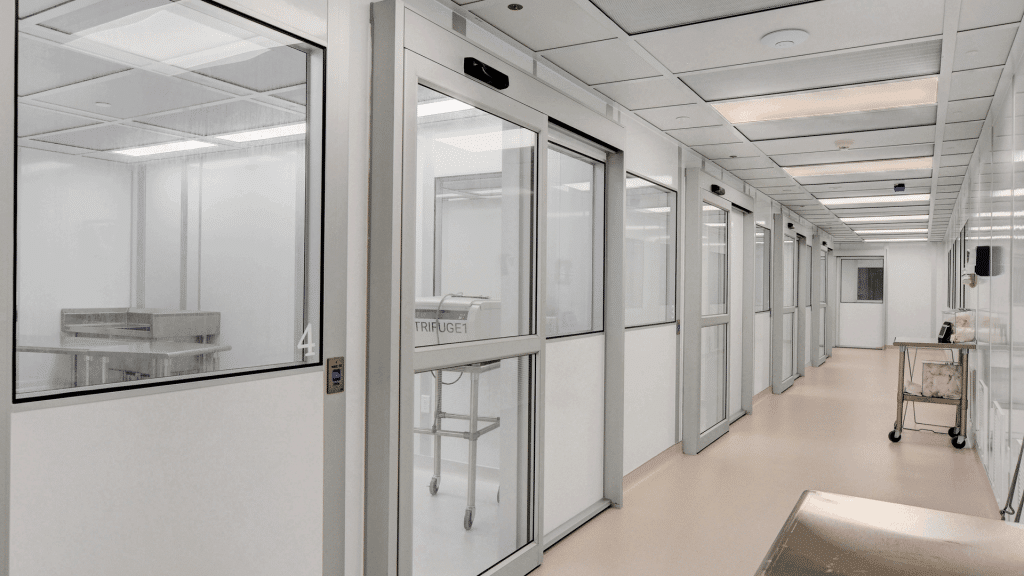
Contact
Leave Your Cleanroom in Expert Hands
FAQs About Healthcare & Hospital Cleanrooms
What ISO class applies to surgical operating rooms?
Surgical operating rooms are typically designed to meet ISO Class 7 or better, depending on the procedure type and national healthcare regulations.
What is the difference between healthcare and pharmaceutical cleanrooms?
Healthcare cleanrooms emphasize infection control and patient safety, while pharmaceutical cleanrooms focus on production sterility for drugs and biologics.
What materials work best in high-disinfectant hospital environments?
FRP and stainless steel with antimicrobial coatings offer the best resistance to cleaning agents and repeated sterilization.
How do gowning rooms and pass-throughs improve infection control?
They serve as controlled barriers that reduce contamination transfer between clean and non-clean zones.
Can modular healthcare cleanrooms be installed in operating hospitals?
Yes. Factory-built systems can be deployed in active facilities with minimal dust, noise, and downtime.


